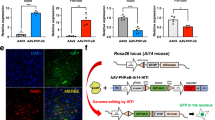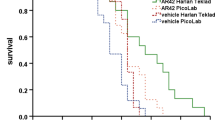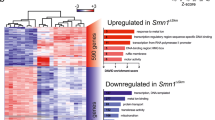Abstract
Establishing human cell models of spinal muscular atrophy (SMA) to mimic motor neuron-specific phenotypes holds the key to understanding the pathogenesis of this devastating disease. Here, we developed a closely representative cell model of SMA by knocking down the disease-determining gene, survival motor neuron (SMN), in human embryonic stem cells (hESCs). Our study with this cell model demonstrated that knocking down of SMN does not interfere with neural induction or the initial specification of spinal motor neurons. Notably, the axonal outgrowth of spinal motor neurons was significantly impaired and these disease-mimicking neurons subsequently degenerated. Furthermore, these disease phenotypes were caused by SMN-full length (SMN-FL) but not SMN-Δ7 (lacking exon 7) knockdown, and were specific to spinal motor neurons. Restoring the expression of SMN-FL completely ameliorated all of the disease phenotypes, including specific axonal defects and motor neuron loss. Finally, knockdown of SMN-FL led to excessive mitochondrial oxidative stress in human motor neuron progenitors. The involvement of oxidative stress in the degeneration of spinal motor neurons in the SMA cell model was further confirmed by the administration of N-acetylcysteine, a potent antioxidant, which prevented disease-related apoptosis and subsequent motor neuron death. Thus, we report here the successful establishment of an hESC-based SMA model, which exhibits disease gene isoform specificity, cell type specificity, and phenotype reversibility. Our model provides a unique paradigm for studying how motor neurons specifically degenerate and highlights the potential importance of antioxidants for the treatment of SMA.
Similar content being viewed by others
Log in or create a free account to read this content
Gain free access to this article, as well as selected content from this journal and more on nature.com
or
References
Pearn JH, Gardner-Medwin D, Wilson J . A clinical study of chronic childhood spinal muscular atrophy. A review of 141 cases. J Neurol Sci 1978; 38:23–37.
Lefebvre S, Burglen L, Reboullet S, et al. Identification and characterization of a spinal muscular atrophy-determining gene. Cell 1995; 80:155–165.
Rochette CF, Gilbert N, Simard LR . SMN gene duplication and the emergence of the SMN2 gene occurred in distinct hominids: SMN2 is unique to Homo sapiens. Hum Genet 2001; 108:255–266.
Lorson CL, Hahnen E, Androphy EJ, Wirth B . A single nucleotide in the SMN gene regulates splicing and is responsible for spinal muscular atrophy. Proc Natl Acad Sci USA 1999; 96:6307–6311.
Monani UR, Lorson CL, Parsons DW, et al. A single nucleotide difference that alters splicing patterns distinguishes the SMA gene SMN1 from the copy gene SMN2. Hum Mol Genet 1999; 8:1177–1183.
Wirth B, Brichta L, Hahnen E . Spinal muscular atrophy: from gene to therapy. Semin Pediatr Neurol 2006; 13:121–131.
Liu Q, Dreyfuss G . A novel nuclear structure containing the survival of motor neurons protein. EMBO J 1996; 15:3555–3565.
Young PJ, Le TT, thi Man N, Burghes AH, Morris GE . The relationship between SMN, the spinal muscular atrophy protein, and nuclear coiled bodies in differentiated tissues and cultured cells. Exp Cell Res 2000; 256:365–374.
Fischer U, Liu Q, Dreyfuss G . The SMN-SIP1 complex has an essential role in spliceosomal snRNP biogenesis. Cell 1997; 90:1023–1029.
Pellizzoni L, Kataoka N, Charroux B, Dreyfuss G . A novel function for SMN, the spinal muscular atrophy disease gene product, in pre-mRNA splicing. Cell 1998; 95:615–624.
Winkler C, Eggert C, Gradl D, et al. Reduced U snRNP assembly causes motor axon degeneration in an animal model for spinal muscular atrophy. Genes Dev 2005; 19:2320–2330.
Fan L, Simard LR . Survival motor neuron (SMN) protein: role in neurite outgrowth and neuromuscular maturation during neuronal differentiation and development. Hum Mol Genet 2002; 11:1605–1614.
Zhang HL, Pan F, Hong D, et al. Active transport of the survival motor neuron protein and the role of exon-7 in cytoplasmic localization. J Neurosci 2003; 23:6627–6637.
Rossoll W, Jablonka S, Andreassi C, et al. Smn, the spinal muscular atrophy-determining gene product, modulates axon growth and localization of beta-actin mRNA in growth cones of motoneurons. J Cell Biol 2003; 163:801–812.
Thomson JA, Itskovitz-Eldor J, Shapiro SS, et al. Embryonic stem cell lines derived from human blastocysts. Science 1998; 282:1145–1147.
Lee H, Shamy GA, Elkabetz Y, et al. Directed differentiation and transplantation of human embryonic stem cell-derived motoneurons. Stem Cells 2007; 25:1931–1939.
Li XJ, Du ZW, Zarnowska ED, et al. Specification of motoneurons from human embryonic stem cells. Nat Biotechnol 2005; 23:215–221.
Singh Roy N, Nakano T, Xuing L, et al. Enhancer-specified GFP-based FACS purification of human spinal motor neurons from embryonic stem cells. Exp Neurol 2005; 196:224–234.
Perrier AL, Tabar V, Barberi T, et al. Derivation of midbrain dopamine neurons from human embryonic stem cells. Proc Natl Acad Sci USA 2004; 101:12543–12548.
Roy NS, Cleren C, Singh SK, et al. Functional engraftment of human ES cell-derived dopaminergic neurons enriched by coculture with telomerase-immortalized midbrain astrocytes. Nat Med 2006; 12:1259–1268.
Yan Y, Yang D, Zarnowska ED, et al. Directed differentiation of dopaminergic neuronal subtypes from human embryonic stem cells. Stem Cells 2005; 23:781–790.
Boulting GL, Kiskinis E, Croft GF, et al. A functionally characterized test set of human induced pluripotent stem cells. Nat Biotechnol 2011; 29:279–286.
Hu BY, Weick JP, Yu J, et al. Neural differentiation of human induced pluripotent stem cells follows developmental principles but with variable potency. Proc Natl Acad Sci USA 2010; 107:4335–4340.
Zeng H, Guo M, Martins-Taylor K, et al. Specification of region-specific neurons including forebrain glutamatergic neurons from human induced pluripotent stem cells. PLoS One 2010; 5:e11853.
Chang T, Zheng W, Tsark W, et al. Brief report: phenotypic rescue of induced pluripotent stem cell-derived motoneurons of a spinal muscular atrophy patient. Stem Cells 2011; 29:2090–2093.
Ebert AD, Yu J, Rose FF Jr, et al. Induced pluripotent stem cells from a spinal muscular atrophy patient. Nature 2009; 457:277–280.
Li XJ, Hu BY, Jones SA, et al. Directed differentiation of ventral spinal progenitors and motor neurons from human embryonic stem cells by small molecules. Stem Cells 2008; 26:886–893.
Li XJ, Zhang X, Johnson MA, et al. Coordination of sonic hedgehog and Wnt signaling determines ventral and dorsal telencephalic neuron types from human embryonic stem cells. Development 2009; 136:4055–4063.
Pankratz MT, Li XJ, Lavaute TM, et al. Directed neural differentiation of human embryonic stem cells via an obligated primitive anterior stage. Stem Cells 2007; 25:1511–1520.
Arlotta P, Molyneaux BJ, Chen J, et al. Neuronal subtype-specific genes that control corticospinal motor neuron development in vivo. Neuron 2005; 45:207–221.
Acsadi G, Lee I, Li X, et al. Mitochondrial dysfunction in a neural cell model of spinal muscular atrophy. J Neurosci Res 2009; 87:2748–2756.
Monani UR . Spinal muscular atrophy: a deficiency in a ubiquitous protein; a motor neuron-specific disease. Neuron 2005; 48:885–896.
Li XJ, Zhang SC . In vitro differentiation of neural precursors from human embryonic stem cells. Methods Mol Biol 2006; 331:169–177.
Brunet N, Tarabal O, Portero-Otin M, et al. Survival and death of mature avian motoneurons in organotypic slice culture: trophic requirements for survival and different types of degeneration. J Comp Neurol 2007; 501:669–690.
Henderson CE, Phillips HS, Pollock RA, et al. GDNF: a potent survival factor for motoneurons present in peripheral nerve and muscle. Science 1994; 266:1062–1064.
Sendtner M, Pei G, Beck M, Schweizer U, Wiese S . Developmental motoneuron cell death and neurotrophic factors. Cell Tissue Res 2000; 301:71–84.
Johnson MA, Weick JP, Pearce RA, Zhang SC . Functional neural development from human embryonic stem cells: accelerated synaptic activity via astrocyte coculture. J Neurosci 2007; 27:3069–3077.
Zhang SC, Wernig M, Duncan ID, Brustle O, Thomson JA . In vitro differentiation of transplantable neural precursors from human embryonic stem cells. Nat Biotechnol 2001; 19:1129–1133.
Qian X, Shen Q, Goderie SK, et al. Timing of CNS cell generation: a programmed sequence of neuron and glial cell production from isolated murine cortical stem cells. Neuron 2000; 28:69–80.
Chamberlain SJ, Chen PF, Ng KY, et al. Induced pluripotent stem cell models of the genomic imprinting disorders Angelman and Prader-Willi syndromes. Proc Natl Acad Sci USA 2010; 107:17668–17673.
Karumbayaram S, Kelly TK, Paucar AA, et al. Human embryonic stem cell-derived motor neurons expressing SOD1 mutants exhibit typical signs of motor neuron degeneration linked to ALS. Dis Model Mech 2009; 2:189–195.
Kiskinis E, Eggan K . Progress toward the clinical application of patient-specific pluripotent stem cells. J Clin Invest 2010; 120:51–59.
Lee G, Papapetrou EP, Kim H, et al. Modelling pathogenesis and treatment of familial dysautonomia using patient-specific iPSCs. Nature 2009; 461:402–406.
Walsh RM, Hochedlinger K . Modeling Rett syndrome with stem cells. Cell 2010; 143:499–500.
Zhang X, Huang CT, Chen J, et al. Pax6 is a human neuroectoderm cell fate determinant. Cell Stem Cell 2010; 7:90–100.
Acknowledgements
We are grateful to Xiaonan Xin, Mary L Stover, and Alex Lichtler for their technical support on making adenovirus. We also thank Yoshiki Sasai (Kyoto University, Japan) for generously providing the FOXG1 antibody. This study was supported by Connecticut Stem Cell Research Grants (08-SCB-UCHC-022 and 11SCB24 to XJ L), and Science and Technology Commission of Shanghai Municipality of China (11PJ1410000 to XZ).
Author information
Authors and Affiliations
Corresponding author
Additional information
( Supplementary information is linked to the online version of the paper on the Cell Research website.)
Supplementary information
Supplementary information, Figure S1
The mRNA expression of SMN-FL, SMN-Δ7, and Olig2 was compared between interneuron-enriched cultures (RA alone group) and motor neuron-enriched cultures (RA + purmorphamine group) on day 26 after differentiation. (PDF 77 kb)
Supplementary information, Figure S2
Schematic map of pLVTHM containing shRNAs that target SMN-FL, SMN-Δ7, and luciferase. (PDF 48 kb)
Supplementary information, Figure S3
The mRNA expression of SMN-Δ7 in neuroepithelia (NE, day 17) and motor neuron cultures (MN, day 33) differentiated from SMN-Δ7 RNAi or luciferase RNAi hESCs was examined by qPCR. (PDF 44 kb)
Supplementary information, Figure S4
One month after differentiation, motor neuron-enriched (RA + purmorphamine treatment) or interneuron-enriched (RA alone group) cells were plated on coverslips. (PDF 39 kb)
Supplementary information, Figure S5
Knockdown of SMN-FL in H1 hESC line led to similar axonal outgrowth deficits as those in H9 hESCs. (PDF 130 kb)
Supplementary information, Figure S6
Neural differentiation from hESCs in the absence of caudalizing factors. (PDF 48 kb)
Supplementary information, Figure S7
Knockdown of SMN-FL using the other shRNA resulted in impaired axonal outgrowth and motor neuron degeneration. (PDF 199 kb)
Supplementary information, Figure S8
Cre was applied to the NE cells that were derived from SMN-FL RNAi hESCs. (PDF 50 kb)
Rights and permissions
About this article
Cite this article
Wang, ZB., Zhang, X. & Li, XJ. Recapitulation of spinal motor neuron-specific disease phenotypes in a human cell model of spinal muscular atrophy. Cell Res 23, 378–393 (2013). https://doi.org/10.1038/cr.2012.166
Received:
Revised:
Accepted:
Published:
Issue date:
DOI: https://doi.org/10.1038/cr.2012.166
Keywords
This article is cited by
-
Generation of functional posterior spinal motor neurons from hPSCs-derived human spinal cord neural progenitor cells
Cell Regeneration (2023)
-
Dysfunctional mitochondria accumulate in a skeletal muscle knockout model of Smn1, the causal gene of spinal muscular atrophy
Cell Death & Disease (2023)
-
A directional 3D neurite outgrowth model for studying motor axon biology and disease
Scientific Reports (2021)
-
Revisiting the role of mitochondria in spinal muscular atrophy
Cellular and Molecular Life Sciences (2021)
-
Cell cycle inhibitors protect motor neurons in an organoid model of Spinal Muscular Atrophy
Cell Death & Disease (2018)



